#is an active synagogue in Prague
Text

#Jubilee Synagogue#also known as the Jerusalem Synagogue for its location on Jerusalem Street#is an active synagogue in Prague#Czech Republic. It was built in 1906#designed by Wilhelm Stiassny and named in honor of the silver Jubilee of Emperor Franz Joseph I of Austria.
6 notes
·
View notes
Text

Jubilee Synagogue (Czech: Jubilejní synagoga), also known as the Jerusalem Synagogue (Czech: Jeruzalémská synagoga) for its location on Jerusalem Street, is an active synagogue in Prague, Czech Republic. It was built in 1906, designed by Wilhelm Stiassny and named in honor of the silver Jubilee of Emperor Franz Joseph I of Austria. Although originally built as a "reform" synagogue (with an organ and a choir), it is nowadays used by the more traditional ("modern orthodox") members of the Prague Jewish community, aligning itself officially with orthodox Judaism. Still, compared to the famous other active synagogue of Prague, the Old-New Synagogue, the Jubilee Synagogue is far less stringent in many ways.
0 notes
Text
Prague - Day 3
Another beautiful day in The City of a Thousand Spires! The day started with us traveling up to the other side of the river to visit the Prague Palace and surrounding monastery. We got to see some beautiful vistas and views of the whole city, as well as get to see some of the old areas of the town that have been walked by various politicians & royalty. We also got to see the area known as “The Gate to Hell” where a prince’s mother once allegedly was dragged to hell because she cursed out the Almighty when her driver was trying to pray. This is of course a legend, but it is a GOOD one. We also got to see members of the castle band, on their way to preform.
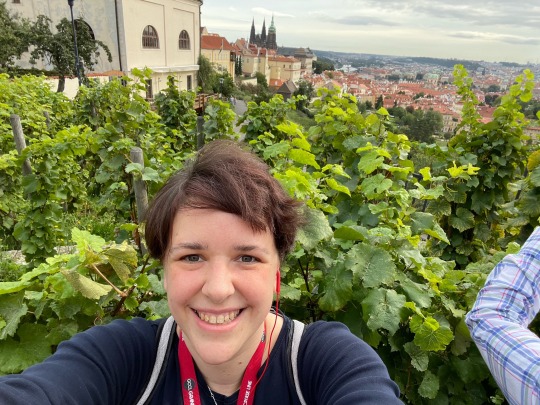
We then made our way to the castle, and especially the Viritus Cathedral. The castle has its own set of guards, their uniforms designed by Theodore Pištêk, the Oscar winning costume creator for the movie “Amadeus”, and the choreography of the changing of the guard developed by Miloš Forman, who choreographed “Hair”. We did not get to go into the castle but we did get to go inside the cathedral. The stained glass was utterly gorgeous (as to be expected) and it was so cool to see how the cathedral has grown and developed through the ages. The gargoyles were pretty cool to see as well, even more fun than the ones I used to see outside the National Cathedral in DC.



We took the longer way through towards lunch, getting to walk through some beautiful gardens, including one with a koi pond in the middle. There were peacocks walking around the gardens, who were very pleased to be appreciated by passerby’s. After a filling lunch, we made our way towards the Charles Bridge, and in doing so passed by the John Lennon wall. I had only read about this piece of artwork but seeing it in person was seriously really cool. Especially to see all the different messages and artwork from the years layered on top creating a unique mosaic of statements of goodwill and love. Mom of course had to get a picture of me in front of it; its only fair since I’ve loved The Beatles since I was in the womb.
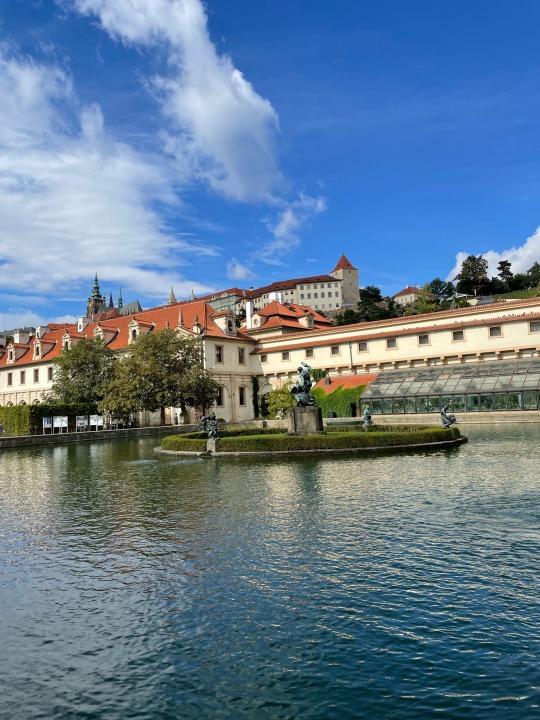
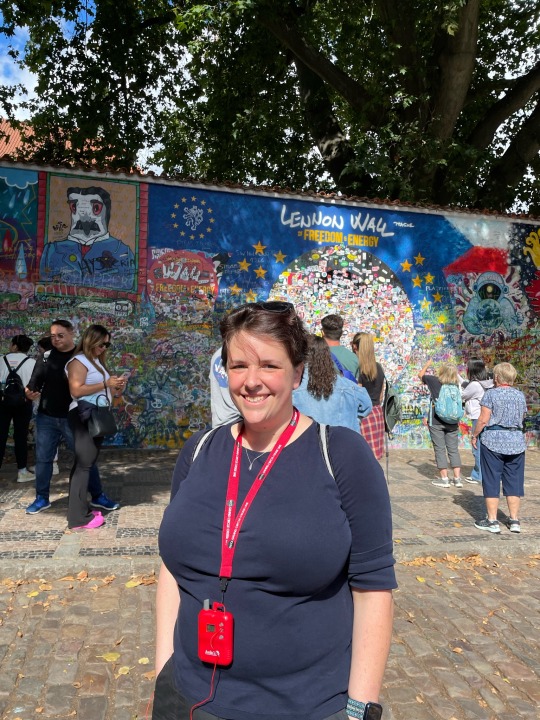
The afternoon saw us on a tour of the Jewish Quarter of the city. I was very excited to see this area of the town because I had read stories of the strength of the Czech people during WWII and I also wanted to see some of the synagogues of the area. My mother & I are not Jewish but some of the people we have loved the best are Jewish & we have been honored to witness some of the Jewish traditions throughout the years. The focus of the tour spoke on the struggles of the Jewish community prior to WWII and during it, and then the effects of the rise of communism in the area. Turns out that due to the collection of interconnected synagogues in the city, along with the memorial stones (called “Stumbling Stones”) along the streets of the quarter, make Prague the location of the largest Jewish museum in the world & the largest Holocaust Memorial in the world. We got to visit some gorgeous synagogues, two which are still active & holding routine prayer services. The highlight was getting to visit the Old-New Synagogue, the oldest synagogue in all of Central Europe. In one of the the non-active synagogues, it was created into a memorial of the all of the names of Jews lost in the Holocaust that lived in the area previously known as Czechoslovakia, which we found out also contained the names of the grandparents of Madeline Albright. Upstairs was a collection of children’s artwork that have been preserved from art therapy sessions given to the children of the Terezin ghetto, as a way for the children to process the changes in the world around them and find hope even in what could be construed as ultimate darkness. As someone who has used art as a way to help her own clients heal and find meaning in their complicated world, seeing all the beautiful pieces of artwork just reminded me how powerful visual media can be for someone so young.
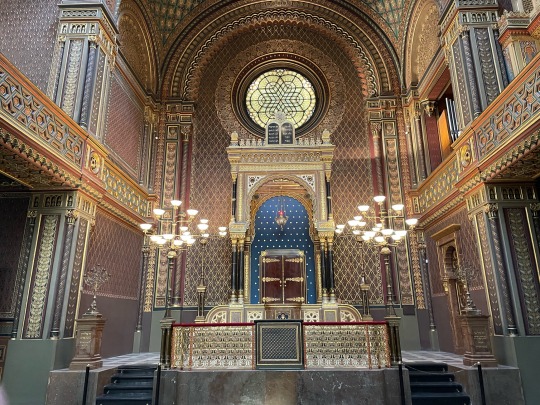
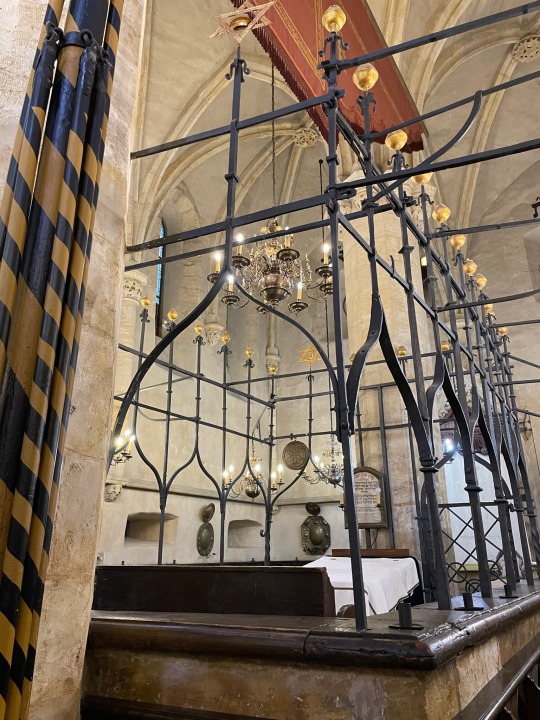
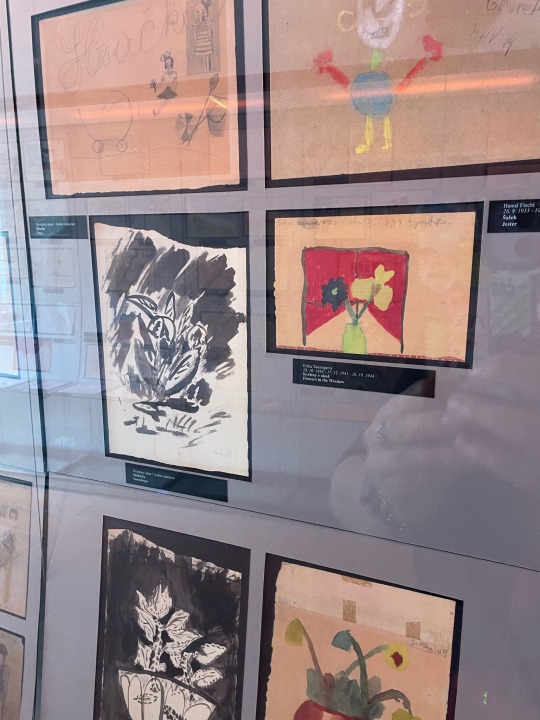
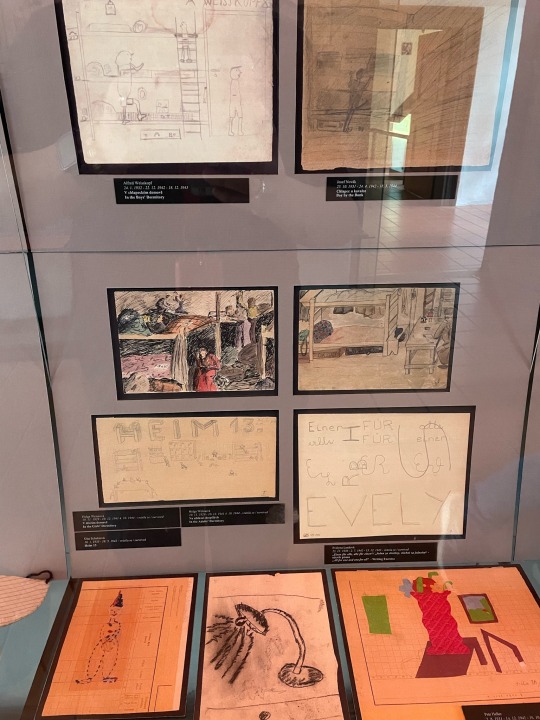
After the tour Mom & I made our way back to the hotel and later out to grab some pizza at a nearby restaurant with our companions on the Jewish Quarter tour. A long day, but so incredibly interesting.
Tomorrow we head to Česky Krumlov, which I hear will be absolutely gorgeous. So I say farewell for now & I will report back again tomorrow evening!
Lowrs💜
0 notes
Text
WEEK 1: Arriving in Prague!
Dobry den!! I finally made it and I couldn’t be happier to be here! I checked into my apartment in Prague 2 (the best location in my opinion) and it’s pretty nice! I share a room with my friend Alyse and we have our own bathroom attached to the room. The kitchen/living room area is also very spacious and can accommodate lots of people! I met my roommates and we were all instantly best friends- I got so lucky!!


My roommates and I and the living area of our apartment
On our first weekend here, we checked out so many cool restaurants, parks, cafes, and historical sights. One of my favorite spots was Manifesto Market in Andel. I saw it on tik tok and it was super cool! So many options for food- I got a poke bowl and my roommates got tacos and everything was so good! I definitely want to come back when it’s less busy and sit by the pool!

Manifesto market in Andel
One of our favorite activities to do here is watch the sunset at a park beer garden. So far, my favorites are Riegrovy Sady and Letna Park. So many people come to sit on a blanket and enjoy the evening and it’s so pretty! (You can see the Prague Castle in the background if you look closely)


Sunset at Riegrovy Sady
Speaking of Prague Castle, I went there with my sister when she came to visit this weekend, and it was so cool! You can see the whole city from the top! I was also able to come back this week with my class, and we climbed 300 stairs to the top of the tower!


Prague Castle
We started classes at the CEA center, and my apartment is about a 30 minute walk away, which I like to do (rather than tram) to get some exercise before class. I really like my linear algebra class so far- it’s very interesting to me and I love math. There’s about ten people in our class, and one of them is a girl in my apartment building. This has been very helpful because we’ve been walking there, getting lunch in between classes (The Spot and Cacao Prague are good cafes right near CEA), and tramming home together. My other class about art history is also pretty interesting, and we get to do a “field visit” in every class! It’s very interesting to walk around the city and see things about Prague’s history, art, and architecture, because there are a lot of sights I wouldn’t have known about otherwise. So far, we’ve been to some Jewish synagogues, the St. Agnes Convent, and the Prague Castle.


The CEA Center and a synagogue
I’m going to start sharing some of my favorite things each week!
Weekly favorites:
Cafe: Cafe Mistral (super cute study spot)
Rooftop: Terrace at Hotel U Prince (the picture of my roommates and I)
Restaurant: Manifesto Andel
Coffee: iced caramel latte with almond milk at Cacao Prague (very American I know)
Food: blueberry pancakes at the Flat Cafe
Sight: Prague Castle
Thanks for following along during my first week in Prague!! So many more fun adventures to come!
Parker Peterson
Industrial and Operations Engineering
Engineering in Prague
0 notes
Photo

International Holocaust Remembrance Day. Prague, the gothic Old-New Synagogue is the oldest active synagogue of Europe. According to the legends angels have brought stones from the Temple in Jerusalem, “on condition” that they are to be returned when the Messiah comes and the stones are needed to rebuild the Temple. #internationalholocaustremembranceday #shoah #prague #synagogue #onassignment #travelmagazine #travelphotographer #bbctravel #cnntravel #awesomeplaces #natgeo #huffpostgram #letsgosomewhere #visitczechrepublic #traveltheworld #travel #aroundtheworld #nationalgeographic #traveljournalist https://www.instagram.com/p/Cn7BjdcsWyG/?igshid=NGJjMDIxMWI=
#internationalholocaustremembranceday#shoah#prague#synagogue#onassignment#travelmagazine#travelphotographer#bbctravel#cnntravel#awesomeplaces#natgeo#huffpostgram#letsgosomewhere#visitczechrepublic#traveltheworld#travel#aroundtheworld#nationalgeographic#traveljournalist
1 note
·
View note
Text






Gothic Buildings of Prague, Bohemia, Czech Republic
Powder Tower, Old Town
St. Wenceslas Church, Zderaz, New Town
Church of Our Lady before Týn, Old Town
Old Town Bridge Tower
Lesser Town Bridge Tower, Malá Strana
Old New Synagogue, Josefov - The oldest active synagogue in the world
(Hans Peter Schaefer, JanRys, Tony Hisgett, Alf van Beem, Øyvind Holmstad)
#gothic#gothic architecture#gothic church#gothic tower#gothic synagogue#prague#bohemia#czech republic#czechia
32 notes
·
View notes
Text
So...Lilith
So I did not think my responses would be reblogged by @veiledlight-blog and @ohmourningstar but I want to continue the discussion on Lilith which isn’t a reblog chain but instead a full post.
So, why not use Lilith in your practice?
Because you’re not Jewish. Lilith is Jewish. You are not. Judaism is a closed practice for a reason. You aren’t supposed to use the stuff there if you aren’t Jewish. Maybe I have to explain why it’s closed.
Anti-semitism is a big issue. It’s everywhere all around the globe. Closed practices are closed to keep the practice how it is without being colonized, and Judaism is no exception. The Jewish people are often discriminated against. I could go on a full rant on how.
My Sunday school classmates have found nazi symbols spray painted onto walls near their homes. My Jewish friends have been made fun of for being Jewish. I’ve personally been threatened with violence and possible death for being Jewish. It’s caused a long issue with my self identity and my religious beliefs which I still struggle with now. I have often not wanted to be Jewish because I felt so ashamed and bad about it. I didn’t want a Bat Mitzvah in case others found out because I knew telling my friends might bring up a side of them I had no clue about or letting others who would also harm me know about my Judaism. It worsened my mental health which was already not good. And guess what? I was a kid. Not even thirteen when this all happened. No kid should go through that. No kid should hate who they are and what they believe because of others and their hate.
Judaism at its root is meant to protect its people from those who want to harm those who practice it. The whole book of Exodus was about escaping the Pharaoh who enslaved us and finding a new home. We have countless stories about it (the Prague Golem is an amazing one). We have the Holocaust. We’ve been taught by the world to keep closed to ourselves. Its figures like Lilith are not for those who are not Jewish.
Now, Lilith has become so popular because her whole concept has been changed from what it once was. Lilith was a high figure, not to be messed with and a literal demon who could and would harm babies and their mothers. Now she’s all succubus queen empowering women. While I am very happy that women, especially young witches, can feel empowered, there’s many, many ladies in other pantheons who are more appropriate for goyim (those who are not Jewish). Honestly, if i were a non-Jewish witch I would love Eve and even as a Jewish witch I still love her. Like your free will? Thank her. Stay away from the lady who was written to eat babies.
Also, young witches are also a big problem when it comes to this. You're naive. Hell I’m still young I’m definitely still naive. But I’m learning. You should be too, learning what you shouldn’t use in your practice because it’s appropriation.
And I mentioned before in my responses that some people have deities and entities come to them, not the other way around. I’ve dealt with this situation with another involving Lilith as said deity/entity before. Let’s have a hypothetical situation. You see Loki in your dreams. You’re not a Norse Pagan. He talks to you. When you wake up you feel this connection between you and him. You research. You find out about Norse Paganism and since you feel so connected to one of its deities, you study more of it and eventually become a Norse Pagan. People can get involved in certain religions or practices because of such experiences. Why can’t the same be done with Liltih and Judaism?
Now, Norse Paganism is an open practice. With closed ones it’s different, especially with African and Native American practices. But I say the underlying concepts and ideas still apply in concerns to Judaism. You’re free to join us. If you actually really feel connected to her, then I bet you 9/10 you’ll feel connected to Judaism and its concepts as well and end up converting. It’s a long process and yes, it’ll require a lot of work. But if you really want it you’ll do it. Getting into studying magic in itself is a massive undertaking. If you want it, you can do it. And if you want to become Jewish you can do it if you really want it.
I know many young witches who want to work with Lilith will say “but I’m too young I can’t convert!” Well guess what? If you really want it you can sit down and wait and when you’re 18 you can convert. Study Judaism in the meanwhile. Help out your local Jewish community. Be an ally to us. We’ll greatly appreciate it and it’ll help with the conversion. If it’s too much of a hassle to wait, hopefully you’ll learn you made a mistake as your young naive self and have more wisdom for your practice, because we all make mistakes and we all should learn from them. And definitely still stand with us as an ally against anti-semitism! And if you still work with and worship her after all that without the conversion, then you’re just an approperiating asshole. Why she would want to work with you is beyond me. Even being “against anti-semitism” is a futile effort because clearly no you’re not.
Also, please do not work with Lilith while you’re converting. Wait till after. You made it so far doing it all right only to ruin it by doing that. Plus by doing so you’re honestly just showing 1) you only converted for Lilith 2) you don’t actually respect the rest of Judaism and 3) Honestly you’re just an asshole trying to cover your tracks.
For any witches who do fully convert or those thinking on it: you can still be a witch and do pagan things as a Jew! Look at me. Look at my mom. Look at @will-o-the-witch. Nobody will judge you for it (you’ll find we’re a very open-minded and accepting community). Even rabbis will be open to it and might give you resources! So don’t be scared. We’ll welcome you.
One big thing, don’t just do nothing when you are officially Jewish. Attend services at a synagogue. Help out at your local JCC. Celebrate the holidays. Don’t just turn Jewish because some kid on Tumblr told you to if you wanted to work with Lilith. If you’re just going to ignore all of it when it’s done, then why even bother? It makes you another asshole just covering their tracks. If this is what you’re gonna do, don’t do it.
Also, please note my whole ramble on conversion is meant for people who genuinely feel a powerful connection to Lilith which should extend to the whole of Judaism. Don’t convert or even consider it if you’re only vaguely interested in her and the religion. Research is fine but active practice is a whole new bucket of worms. You’ll waste your time and everyone else’s time with a conversion if you’re not fully involved and into it. Attend or watch (with the pandemic and that) a service or two and see how you think of it. Research research research as well and decide after you’ve done the two. It’ll likely be a no at the end if you are not genuinely interested. Or you may end up genuinely interested in Judaism by doing those things. Just always make sure you’re 100% confident in your choice for this if you’re going to actually convert. It’s a big move and not one to be taken lightly.
So, TLDR for the whole conversion thing: you either end up realizing your mistake and growing as a person and witch, you reveal yourself as a true asshole, or you end up in a community you’re happy in. Think hard and long. Question your interest and connections. Don’t not get involved in Jewish things if you do convert.
I didn’t expect this to end up mostly about conversion at the end but oh well. I hope this helps or provides some insight. For any questions please just dm or send me an ask. Any anti-semitism or hate will be ignored because I don’t have time for your shit.
#judaism#cultural appropriation#cultural appropriation in witchcraft#lilith#long post#antisemitism#conversion
778 notes
·
View notes
Text
The British Schindler
He saved 669 children.
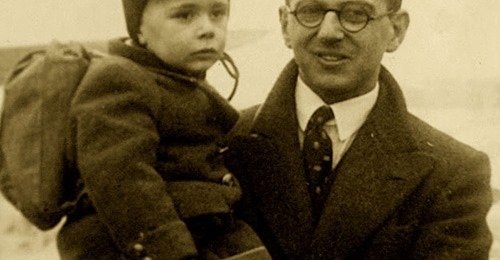
Nicholas Winton was a young British stockbroker who rescued 669 Czech Jewish children from being sent to Nazi death camps. He never told anybody of his heroism, and the story only came out 50 years later after his wife found an old briefcase in the attic containing lists of children he’d saved.
Nicholas was a 29 year old clerk at the London stock exchange getting ready for a ski trip to Switzerland when he received an urgent call from his friend Martin Blake. Known to be passionately opposed to Nazism, Martin urged Nicholas to cancel his vacation and come to Prague immediately. He told Nicolas, “I have a most interesting assignment and I need your help. Don’t bother bringing your skis.”
It is a testament to Nicolas’ sterling character and strong moral compass that he didn’t waver for a moment. It was an easy decision to sacrifice his fun and relaxing ski trip and instead travel to a dangerous place on a mysterious mission.
Two months earlier, in October 1938, Nazi Germany had annexed the Sudetenland It was clear that the Nazis would soon occupy all of Czechoslovakia. When he reached Prague, Nicholas was shocked by the huge influx of refugees fleeing from the Nazis. In early November, the Kristallnacht pogrom occurred in Germany and Austria. Jews were killed in the street and hundreds of synagogues burned down, as well as Jewish-owned businesses. This horrifying event shocked the Jewish community in eastern Europe, and thousands were now desperate to flee.
Born to Jewish parents, Nicholas was actually Jewish himself. However, his parents changed their name from Wertheim and converted to Christianity before he was born. Nicholas was baptized and raised as a Christian, and he didn’t consider himself Jewish (although was doubtless aware that Hitler would.)
In Prague, organizations were springing up to help sick and elderly refugees, but Nicholas noticed that nobody was trying to help the children. In his words, “I found out that the children of refugees and other groups of people who were enemies of Hitler weren’t being looked after. I decided to try to get permits to Britain for them. I found out that the conditions which were laid down for bringing in a child were chiefly that you had a family that was willing and able to look after the child, and fifty pounds, which was quite a large sum of money in those days, that was to be deposited at the Home Office. The situation was heartbreaking. Many of the refugees hadn’t the price of a meal. Some of the mothers tried desperately to get money to buy food for themselves and their children. The parents desperately wanted at least to get their children to safety when they couldn’t manage to get visas for the whole family. I began to realize what suffering there is when armies start to march.”
Nicholas knew something had to be done, and he decided to be the one to do it. He later remembered, “Everybody in Prague said, ‘Look, there is no organization in Prague to deal with refugee children, nobody will let the children go on their own, but if you want to have a go, have a go.’ And I think there is nothing that can’t be done if it is fundamentally reasonable.”
Nicholas decided to find homes for the children in the UK, where they would be safe. He set up a command center in his hotel room in Wenceslas Square and his first step was to contact the refugee offices of different national governments and see how many children they could accept. Only two countries agreed to take any Jewish children: Sweden and Great Britain, which pledged to accept all children under age 18 as long as they had homes and fifty pounds to pay for their trip home.
With this green light from Great Britain, Nicholas did everything possible to find homes for the children. He returned to London and did much of the planning from there, which enabled him to continue working at the Stock Exchange and soliciting funds from other bankers to pay for his work with the refugees. Winton needed a large amount of money to pay for transportation costs, foster homes, and many other necessities such as food and medicine.
Nicholas placed ads in newspapers large and small all over Great Britain, as well as in hundreds of church and synagogue newsletters. Knowing he had to play on people’s emotions to convince them to open their home to young strangers who didn’t even speak English, Nicholas printed flyers with pictures of children seeking refuge. He was tireless in his efforts and persuaded an incredible number of heroic Brits to welcome the traumatized young refugees into their homes and hearts.
The office in Wenceslas Square was manned by fellow Brit Trevor Chadwick. Every day terrified parents came in and begged him to find temporary homes for their children. Despite Nicholas’ success in finding places for the kids to stay, British and German government bureaucrats made things difficult, demanding multiple forms and documents. Nicholas said, “Officials at the Home Office worked very slowly with the entry visas. We went to them urgently asking for permits, only to be told languidly, ‘Why rush, old boy? Nothing will happen in Europe.’ This was a few months before the war broke out. So we forged the Home Office entry permits.”
The first transport of children boarded airplanes in Prague which took them to Britain. Nicholas organized an amazing seven more transports, all of them by train, and then boat across the English Channel. The children met their foster families at the train station and Winton took great care in making the matches between children and foster parents.
The children’s transport organized by Nicholas Winton was similar to the later, larger Kindertransport operation, but specifically for Czech Jewish children. Nicholas saved an astounding 669 children on eight transports. Tragically, the largest transport of all was scheduled for September 1, 1939 – but on that day, Hitler invaded Poland and all borders were closed by Germany. Winton was haunted for decades by the remembrance of the 250 children he last saw boarding the train. “Within hours of the announcement, the train disappeared. None of the 250 children aboard was seen again. We had 250 families waiting at Liverpool Street that day in vain. If the train had been a day earlier, it would have come through. Not a single one of those children was heard of again, which is an awful feeling.”
Nicholas joined the British military and spent the rest of the war serving as a pilot in the Royal Air Force, attaining the rank of Flight Lieutenant. After the war, Nicholas worked for the International Refugee Organization in Paris, where he met and married Grete Gjelstrup, a Danish secretary. They moved to Maidenhead, in Great Britain, and had three children. Their youngest child, Robin, had Down Syndrome, and at that time children with the condition were usually sent to institutions. However Nicholas and Grete wouldn’t consider it and instead kept their son at home with the family. Tragically, Robin died of meningitis the day before his sixth birthday. Nicholas was devastated by the loss, and became an active volunteer with Mencap, a charity to help people with Down Syndrome and other developmental delays. He remained involved in Mencap for over fifty years.
Humble – and perhaps traumatized by the children on the train he wasn’t able to save – Nicholas rarely talked about his wartime heroism and his own family didn’t know the details. It was only in 1988 that Nicholas Winton became widely known. His wife found an old notebook of his containing lists of the children he saved. Working with a Holocaust researcher, she tracked down some of the children and located eighty of them still living in Britain. These grown children, some with grandchildren, found out for the first time who had saved them.
The BBC television show called That’s Life! invited Nicholas to the filming an episode that became one of the most emotional clips in TV history. With Nicholas in the audience, the host told his story, including photos and details about some of the children he’d saved. Then the told Nicholas that one of those children was the woman in the seat next to him! They embraced, teary eyed, and the host announced there were more grown children in the audience as well. She asked everybody who owed their life to Nicholas Winton to stand up. The entire audience stood up, as Nicholas sat stunned, wiping away the tears.
After that, Nicholas was showered with honors, including a knighthood for services to humanity. Known as the British Schindler, he met the Queen multiple times and received the Pride of Britain Award for Lifetime Achievement, both for saving refugee children and working with Mencap to improve the lives of people with cognitive differences. There are multiple statues of him in Prague and the UK, and his story was the subject of three films.
Nicholas Winton died in Britain in July 2015, at age 106. Today there are tens of thousands of people who owe their lives to Nicholas Winton.
For saving hundreds of Jewish children, we honor Nicholas Winton as this week’s Thursday Hero.
Accidental Talmudist
63 notes
·
View notes
Text




The Old New Synagogue (Czech: Staronová synagoga; German: Altneu-Synagoge), also called the Altneuschul, situated in Josefov, Prague, is Europe's oldest active synagogue.
3 notes
·
View notes
Photo

The Old New Synagogue or Altneuschul (Staronová synagoga) situated in Josefov, Prague, is Europe's oldest active synagogue. Староно́вая синагога (Staronová synagoga) — старейшая действующая синагога Европы... #old #new #staronova #synagogue #europe #prague #active #прага #синагога #старонова #йозефов #новая #старая (at Old New Synagogue)
1 note
·
View note
Link
Each year millions of visitors walk through the cobbled streets of Prague's Old Town - without realising, most likely, that many of the stones below their feet have been looted from what was meant to be sacred ground. The BBC's Rob Cameron only recently learned their secret.
We stood, blocking the pedestrian traffic, on one of the busiest streets in the Czech capital. A steady stream of people pushed by us muttering as they clutched bags of Christmas shopping and souvenirs and we peered at the ground.
In the distance, at the bottom of Wenceslas Square, crowds congregated around street performers and kiosks selling sausages and beer.
"There," said Leo Pavlat, the owlish, bearded director of the Prague Jewish Museum, pointing at a thin strip of dark, square cobblestones at our feet. "There! You see? All along there." He looked up, his eyes following the strip as it ran along the short pedestrianised street.
He delved into a plastic bag and brought out two cobblestones. They were almost identical to those embedded in the ground below us. But these ones you could turn over in your fingers, revealing a single smooth side of polished granite that would otherwise have been hidden face down.
One bore fragments of a date, 1895. The other featured three letters of the Hebrew alphabet - he, vav, bet, the gold paint which lined the chiselled inscriptions glinting in the winter sun.
"What does it mean?" I asked. "Is it part of a name?" Leo frowned. "No idea. It's not enough to tell. Possibly it's part of a eulogy."

Leo Pavlat has owned these stones for more than 30 years, ever since he slipped them into his pocket one spring morning some time in the late 1980s.
"It must have been shortly before Gorbachev came, because I remember they redid the cobblestones here especially for his visit," he said.
Later I looked online and discovered that the Soviet leader first visited Prague in April 1987, and the trip had indeed included an hour-long walkabout at the bottom of Wenceslas Square.
But back to Leo and his cobblestones. On that spring morning just over 30 years ago he was on his way to work in the Albatros children's publishing house, a short distance from where we now stood. He'd passed a sight that's still familiar in Prague today - piles of new cobbles waiting to be laid by workers in overalls and kneepads.
Something about them caught his eye, and he bent down for a closer look. They were fragments of Jewish tombstones that had been cut into perfect cubes of granite. Judging by the dates, they'd been taken from a 19th Century cemetery. Shocked, Leo pocketed a few and walked briskly away.
"It wasn't easy being Jewish back then," he told me. "I was an active member of the community, though not in the official circles. And I wasn't a member of the Communist Party."
Even attending the officially-sanctioned weekly service in one of the few functioning synagogues was enough to prompt a chat with the secret police, he said.
"There were no publications, no education. I think the regime just wanted the Jewish community to slowly die."
Czechoslovakia's Jewish population of some 350,000 people before World War Two, was reduced to about 50,000 in 1946 - including the few who had staggered back from the concentration camps.
Official anti-Semitism and voluntary emigration followed during the decades of communism. By the late 1980s, the population barely numbered 8,000.
And across the country, on the edges of villages and towns, some 600 Jewish cemeteries lay untended and forgotten. The Communist authorities - and, it seems, the leaders of the Jewish community too - saw them as repositories of valuable building material that would otherwise go to waste.
Leo Pavlat couldn't remember where his stones had come from, but directed me to an article he'd written several years before. His cobbles, it seems, were cut from tombstones taken from a Jewish cemetery established in 1864 in the town of Udlice in North Bohemia.
There'd been a Jewish community there since the 17th Century, with a synagogue, yeshiva (a religious school) and two cemeteries. By 1930, the Jewish population of Udlice had fallen to 13. By the 1980s, when its cemetery was looted, it was - presumably - zero...
2K notes
·
View notes
Text
Cheap City Breaks Best Affordable European Destinations 2020
Do you want to travel to Europe? Are you under a small budget? The Gods of travel took care of that already. There are plenty of cheap city breaks in Europe in different affordable European destinations you can choose from.
Don’t break the bank but get the very best in spectacular views, nightlife, history, sightseeing, great beaches, people, alternative activities like a yoga retreat in Europe, or some of the best destinations for Christmas.
Read this for the top 10 safest countries in the world today, and this one for cheap travel destinations in Europe.
Are you are a student who wants to travel? Then this post is for you.
Affordable European Destinations 2020
Cheap European Breaks in Prague, Czech Republic
Porto, Affordable City in Portugal
Cheap City Breaks in Athens, Greece
City Trip to Valencia, Spain
Affordable City Break in Budapest, Hungary
Affordable City Break in Lisbon, Portugal
Istanbul, Turkey, Affordable European Destination
Cheap City Escape in Brussels, Belgium
Cheap City Break in Florence, Italy
Best City Break in Madrid, Spain
Best Cheap Trip to St. Petersburg, Russia
Cheap European Vacations in Rome, Italy
Cheap City Break in Corfu, Greece
Berlin, Germany Cheap Holiday Destination
Seville, Spain Cheap European City
Munich, Germany Cheap Holidays in Europe
Summary of Affordable European Destinations
Affordable European Destinations 2020
There is a secret list of affordable European destinations that frequent travelers know.
Countries and cities included in this list are considered a pivot point for your travel experience. Traveling through these cities gets you acquainted with the essence of Old Europe and its history.
We are here to share these secrets for the best cheap city breaks with you.
Cheap European Breaks in Prague, Czech Republic
Right in the heart of Europe, this spectacular city hides lots of secrets, even a medieval astronomical clock that seems to come from a fiction novel. Read a fascinating post for three days in Prague Itinerary.
What are the best things to do in Prague?
Old Town Square (Staromestské námestí)
Charles Bridge (Karluv most)
Prague Castle
St. Vitus Cathedral (Chrám svatého Víta)
Jewish Quarter (Josefov)
Dancing House
Prague Astronomical Clock
National Theatre (Národní Divadlo)
St. Nicholas Church (Chrám svatého Mikuláse)
When to go to Prague?
To avoid large crowds, better go to Prague in spring and early fall (March-May) when the weather is mild. Avoid the holiday seasons (Christmas, Easter).
During May there is a range of important events taking place too: the Prague Marathon, Czech Beer Festival, Prague Food Festival, Prague International Music Festival.
Prague is fantastic among all European Destinations.
Check accommodation and guided tours/tickets/passes options for Prague.
Porto, Affordable City in Portugal
A stunning coastal city with great architecture, history, food, and museums (museums are free to enter on Sundays). The city hosts the UNESCO World Heritage Ribeira District.
What are the best things to do in Porto?
Dom Luís I Bridge
Sé do Porto (Porto Cathedral)
Jardins do Palácio de Cristal (Crystal Palace Gardens)
Avenida dos Aliados (Avenue of the Allies)
Estação de São Bento (São Bento Railway Station)
Mercado do Bolhão (Bolhão Market)
Porto’s fantastic beaches
Livraria Lello & Irmão (Lello Bookstore)
Igreja de São Francisco (Church of Saint Francis)
Port Wine Tastings & Tours
Palácio da Bolsa (Stock Exchange Palace)
Fundação de Serralves (Serralves Foundation Complex)
Museu Nacional de Soares dos Reis (National Museum Soares dos Reis)
Dragão Stadium
When to go to Porto?
From May to September the weather is warm and sunny. Some significant events happening during that time are Optimus Primavera Sound, Serralves em Festa, Festa de São João, Regata dos Rabelos, Festival Mares Vivas.
Porto is one of the best summer European destinations.
Read our post for Porto.
Here are your options for hotels and guided tours/tickets/passes.
Cheap City Breaks in Athens, Greece
There are plenty of things to do in Athens, despite Parthenon and Acropolis. Many prefer this city for two days itinerary but when you read posts like this one, this and this (all Athens section) you will understand that it is for much more.
Due to its geographical location and weather conditions, it is ideal for 10 out of 12 months.
What are the best things to do in Athens?
In short? Read this long post for Athens and things to do if you want more inspiration this post for 40 things to do in Greece and 14-day trips from Athens. You will thank us.
All parks in Athens are free to enter and churches too. Free admission museums are:
The Museum of the History of Greek Costume
The Philatelic and Postal Museum
Railway Museum of Athens
Theatrical Museum of Greece
Natural History Museum of Maroussi
Athens University History Museum
Museum of Greek Folk Instruments
Centre of Folk Art and Tradition
Hellenic Children’s Museum
Free admission holidays
6th of March – Memory of Melina Mercouri
18th of April – International Monument Day
18th of May International Museum Day
5th of June World Environment Day
European Days of Cultural Heritage (The last weekend of September)
27th of September – International Tourism Day
When for Athens?
It’s in Greece! If you avoid December and January, then all other months are fantastic to go to Athens. Even in wintertime, there are ski resorts in less than 2 hours distance from Athens (two in Peloponnese and one in Parnassos mountain). There are options for hiking, all museums are open, and food remains excellent all year long.
Check here for accommodation and available guided tours.
Athens is one of the most fabulous European destinations, as it is a pivot point for the Greek islands.
City Trip to Valencia, Spain
Affordable and easy to reach with a high-speed train from Barcelona or Madrid. A coastal city, vibrant with history and museums. It is famous for its oranges too, so taste some while there.
What are the best things to do in Valencia?
Central Market (Mercado Central)
Plaza Ayuntamiento
Cathedral (Seu)
Fine Art Museum of Valencia (Museo de Bellas Artes de Valencia)
Instituto Valencia d’Arte Modern (IVAM)
Albufera Nature Park (Parque Natural de la Albufera)
La Lonja de la Seda
Valencia Beaches
Bioparc Valencia
City of the Arts and Sciences (Ciudad de las Artes y las Ciencias)
When it is great to go to Valencia?
April to May is best, though there are plenty of visiting in the wintertime. Keep in mind that museums operate under short ours in the winter. Critical events in that period are The Superbike World Championship, Fiesta de San Vicente Ferrer, Holy Week, Festival of Our Lady of the Forsaken.
Check staying prices and guided tours/tickets/passes options for Valencia.
Affordable City Break in Budapest, Hungary

An aspect of the castle from afar
The city is famous for its food and its baroque, neoclassical and art nouveau architecture. Budapest dates back to the Stone Age and comes with great food options!
What are the best things to do in Budapest?
Fisherman’s Bastion (Halászbástya)
Danube River
Castle Hill (Várhegy)
Széchenyi Chain Bridge (Széchenyi Lánchíd)
Heroes’ Square (Hosök Tere)
St. Stephen’s Basilica (Svent István Bazilika)
Buda Castle (Budai vár)
Matthias Church (Mátyás-Templom)
Dohány Street Synagogue (Dohány Utcai Zsinagóga)
Gellért Hill (Gellért-Hegy)
Hungarian State Opera House (Magyar Állami Operaház)
Hungarian Parliament (Országház)
House of Terror Museum (Terror Háza Múzeum)
Hospital in the Rock Nuclear Bunker Museum (Sziklakórház Atombunker Múzeum)
Budapest Zoo & Botanical Garden
Legenda Sightseeing Boats
Thermal Baths
When is it fantastic to be in Budapest?
March to May and September to November is best. That is if you want to avoid huge crowds of tourists (in summertime). The weather is generally mild. Special events happening during these months are:
March to May: Budapest Dance Festival, Macaron Day, Budapest Spring Festival, Budapest100, Rosalia Festival, OTP Bank Gourmet Festival, Budapest Beer Week.
September to November: Jewish Cultural Festival, Budapest Wine Festival, Sweet Days Chocolate, and Candy Festival, Oktoberfest Budapest, Design Week Budapest, Budapest Christmas Markets.
Here is Budapest accommodation options & tours.
Affordable City Break in Lisbon, Portugal
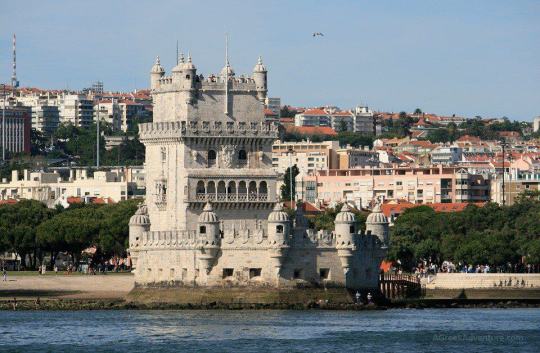
Belem Tower
The city offers at a fraction of the cost whatever you expect to find in a European city. This is another city that emits mystery from Old-World, despite the growth of the modern building. Read this insider’s guide for things to do in Lisbon.
What are the best things to do in Lisbon?
Alfama
Belem
Sintra
Torre de Belem and Monument to the Discoveries
Cascais
Feira da Ladra
Santa Justa Elevator (Elevador de Santa Justa)
St. George’s Castle (Castelo de Sao Jorge)
National Tile Museum (Museu Nacional do Azulejo)
Gulbenkian Museum (Museu Calouste Gulbenkian)
Monastery of St Jerome
Oceanarium (Oceanario de Lisboa)
Taste of Lisboa Food Tours
Lisbon By Boat
Tram 28
When is it best to visit Lisbon?
March to May and September to October is ideal, not excluding other months, too, of course. From March to early June, these events take place: Lisbon Half Marathon, Lisbon Fish & Flavours, Music Days in Belem, IndieLisboa, Festival de Sintra, Out Jazz Festival. On the other hand, the MOTEL X – Lisbon International Film Festival happens in September, while the Out Jazz Festival continues too (May to September).
Read our posts for Lisbon and Lisbon food, Cascais, Sintra, Fatima. There are plenty of day trips from Lisbon to consider.
Book your accommodation early and allow time for guided tours.
Lisbon and the nearby cities make it another great spot among all European destinations.
Istanbul, Turkey, Affordable European Destination
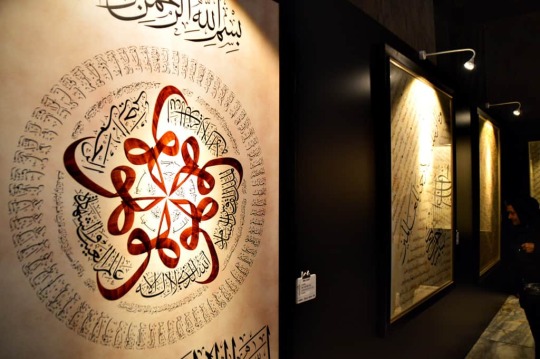
A jewel of the Orient. A city of thousands of secrets and legends, with different locations that drive your mind to thousands of mystical stories.
Herbs & spices, Bosporus, belly dancing, fantastic architecture, and all kinds of landmarks. Istanbul will fill your days with many things while acting as a pivot point for many nearby cities.
It is famous for Agia Sophia and the Blue Mosque, but that is just a fraction of the things to see and do. Read the post from our trip there. For what to eat in Istanbul, read this.
What are the best things to do in Istanbul?
Blue Mosque (Sultanahmet Camii)
Grand Bazaar (Kapaliçarsi)
Süleymaniye Mosque (Süleymaniye Camii)
Taksim Square
Ortaköy
Hagia Sophia Museum (Ayasofya Müzesi)
Istanbul Archaeological Museums (Istanbul Arkeoloji Müzeleri)
Topkapi Palace Museum (Topkapi Sarayi Müzesi)
Istanbul Modern Art Museum
Chora Museum (Kariye Müzesi)
Basilica Cistern (Yerebatan Sarnici)
Dolmanbahçe Palace
Galata Tower (Galata Kulesi)
When it is amazing to visit Istanbul?
Best go there from September to November and from March to May. In the first period, you will have the opportunity to attend these too: Contemporary Istanbul, Istanbul International Puppet Festival, Akbank Jazz Festival, Istanbul Theatre Festival.
In the March to May period, these things happen at the Istanbul Film Festival, Istanbul Music Festival.
For hotels in Istanbul, check these options as well as for guided tours.
Cheap City Escape in Brussels, Belgium
If you crave for some delicious chocolate, then you can visit Brussels even for one day. Take the train from Paris or Amsterdam and savor all these from kiosks you will find in all streets.
Restaurants will be pricey, so no need to pay more for chocolate than needed. There are lots of museums and don’t forget that this is a multicultural & multilingual country.
People here speak Dutch, French & English, of course.
What are the best things to do in Brussels?
Manneken Pis
Grand-Place
St. Michael and St. Gudula Cathedral
Royal Museum of the Army and Military History
Palais de Justice
Mini-Europe
Royal Museums of Fine Arts of Belgium
Musical Instruments Museum
Atomium
Horta Museum
Belgian Comic Strip Center
Cantillon Brewery
When is it nice to be in Brussels?
March to May and September to October is best. In the first case, because it is Springtime while in the second case, prices drop significantly, while the weather stays mild enough.
Check Brussels accommodation prices. Here are the tour options.
Cheap City Break in Florence, Italy

Have we been to Florence, Italy? Yes, twice. The first one was as part of a road trip that involved crossing Europe to the UK driving at the North.
The second one was as part of another road trip getting from the UK to Greece from the South part fo Europe!!! Read this excellent post for Florence (Firenze).
We have traveled to many cities in Italy (including Sicily island). Read the post for things to do in Sicily.
What are the best things to do in Florence?
Piazzale Michelangelo
Ponte Vecchio
Piazza della Signoria
Duomo (Cathedral of Santa Maria del Fiore)
Uffizi Gallery (Galleria degli Uffizi)
Baptistry (Battistero)
Galleria dell’Accademia
Palazzo Pitti
Basilica di Santa Croce
Giotto’s Bell Tower (Campanile di Giotto)
Boboli Gardens (Giardino di Boboli)
When it is most nice to visit Florence?
Preferably from May to September. Lots of sunshine, but you need to search thoroughly for accommodation as in touristy places prices get high.
There is no need to stay in, such though as the city is easy to walk. You can quickly get into the historical center with public transportation.
Either way, you will walk all the historical center to see the things mentioned above.
Check this for staying in Florence and all the tickets & passes options.
Florence is one of the best cultural European destinations, that is seen in video games.
Best City Break in Madrid, Spain
There are so many plaza’s (Madrid is Spain’s largest city) that are free to the public. You can spend days just visiting each other.
However, Madrid is far more than that. Read our post for things to do in Madrid and check the list below too.
What are the best things to do in Madrid?
Plaza Mayor
Gateway of the Sun (Puerta del Sol)
Plaza de Cibeles
El Rastro Market
Temple of Debod
Retiro Park (Parque del Retiro)
Royal Palace of Madrid (Palacio Real)
Prado Museum (Museo Nacional del Prado)
Thyssen-Bornemisza Museum
Mercado San Miguel
Sorolla Museum
Bernabéu Stadium
Queen Sofia Arts Center
When is it excellent to visit Madrid?
The March to May and September to November rule holds for Madrid too. The weather temperature is the main reason for this. Summer in Madrid is scorching due to the city’s geographical location. In Autumn, you can attend the Autumn Festival.
Here are the Madrid lodging prices & tours.
Best Cheap Trip to St. Petersburg, Russia
Russia is a destination where you will get reasonable prices if you book early. Most people will visit Moscow, St. Petersburg, or both on a trip.
Moscow is great for New Year’s Eve, too, while St. Petersburg offers an entirely different experience.
What are the best things to do in St. Petersburg?
Hermitage Museum and the Winter Palace
Church of the Savior on Spilled Blood
Grand Market Russia Interactive Museum
St. Isaac’s Cathedral
Summer Garden
Peterhof Palace & Garden
Russian Museum
Yusupov Palace
The Naval Cathedral of Saint Nicholas in Kronstadt
Chapel of St. Xenia of St. Petersburg
Yelagin Island
When is it great to visit St. Petersburg?
Avoid winter. Better to visit from June to September. Hot events taking place are White Nights, International Festival of Choral Art, International Early Music Festival.
Winter is cheaper, but lots of activities are not happening, and cold in Russia is rather extreme.
Check the best accommodation options and guided tours/ticket/passes options for St. Petersburg.
Cheap European Vacations in Rome, Italy
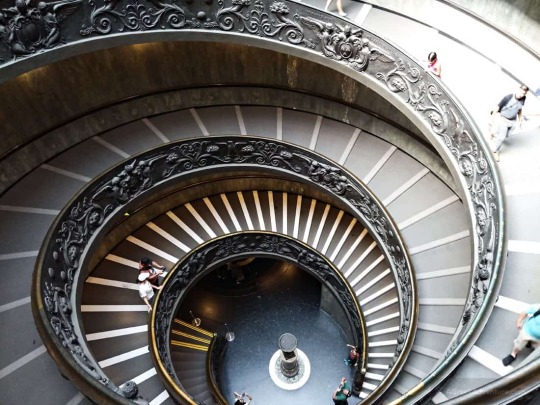
The famous Vatican stairs: Bramante Staircase
The city of Rome is a living, walk-through museum. It is an unbelievable destination suitable for all seasons (not so good when rains fall but still beautiful).
We have been multiple times in Rome with kids or not. It is suitable for going without kids too. Prepare for lots of walking as a car is useless in the vast historical center which covers most of the city of Rome.
What are the best things to do in Rome?
Trevi Fountain (Fontana di Trevi)
Church of San Luigi Dei Francesi
Santa Maria Della Vittoria
Ancient Appian Way
Trastevere
Basilica di San Clemente
Piazza Navona
Gianicolo Hill
Campo de’ Fiori
Porta Portese
Spanish Steps
Musei Capitolini
St. Peter’s Basilica (Basilica di San Pietro)
Pantheon
Colosseum (Colosseo)
Vatican Museums and Sistine Chapel
Roman Forum (Foro Romano)
Palatine Hill
Galleria Borghese
Gruppo Storico Romano Gladiator School
When is it wonderful to visit Rome?
Prices are lower from October to April. The weather is hot in summer, but Rome has free water fountains all over the city, and you will be amazed by the colors of the city with summer light.
You can find lots of affordable accommodations outside of the historical center, but it will still be close to it, so no worries. Better to go there with the sun than rain.
The cold will not be an issue with all the walking (if you plan for winter). Food is affordable if you avoid tourist restaurants.
Check here for where to stay in Rome and all tours with a guide and skip the line tickets.
Cheap City Break in Corfu, Greece
Corfu is a contradictory island, suitable for many different tastes. One of its sides/coasts has lots of beaches while the other one is rocky.
The best beaches will be revealed by the locals when they like you, so make sure they do. This post will be somewhat informative for you.
The islands hold the essence from the Venetian history, and you will notice that in the architecture of its capital.
What are the best things to do in Corfu?
All the beaches
Paleokastritsa Monastery (and beach)
Corfu Donkey Rescue
Church of Saint Spyridon
Corfu Museum of Asian Art
Achillion Palace & Museum
Palaio Frourio (Old Fortress)
Aqualand (lots of fun)
When is it superb to visit Corfu?
Summertime is the best season. In case you want to hit the lowest prices ever then visit Corfu from April to May and September to November.
Corfu is in the West part of Greece, and you can encounter lots of rain during those times. In case you can be there in Orthodox Easter time, you will see lots of local customs happening.
Here is where to stay in Corfu and guided tours.
Berlin, Germany Cheap Holiday Destination
Berlin is a somewhat controversial city with extreme nightlife. If you are after nightlife, then it won’t be very cheap. Many other things come at really affordable prices.
Here is a post with ideas for three days in Berlin and another one for five days in Germany.
What are the best things to do in Berlin?
Brandenburg Gate
Memorial to the Murdered Jews of Europe
Potsdamer Platz
Tiergarten
The topography of Terror
East Side (Wall) Gallery
Reichstag
Museum Island
Pergamonmuseum
Zoologischer Garten Berlin
Checkpoint Charlie
TV Tower
Charlottenburg Palace
When is it thrilling to visit Berlin?
From May to September, you can additionally attend these events: Formula E ePrix Championship, Carnival of Cultures, Fete de la Musique, Berlin Fashion Week, Lesbian and Gay City Festival, International Berlin Beer Festival, Berlin Marathon.
Berlin is at the center of Germany but also in the North of Europe so that any other months will be rather cold.
Find here the Berlin lodging options & tickets for excellent tours and landmarks.
Seville, Spain Cheap European City
With hotels moving around the USD100 per night, this city is affordable too. There are hostels and such if you want to lower the accommodation fees.
There are lots of parks, promenade locations, museums, bull-fights, and tasty food. See more great places to visit in Spain.
What are the best things to do in Seville?
La Carbonerí
Guadalquivir River Cruise
Metropol Parasol
Museum of Fine Arts
Plaza de Toros de la Real Maestranza
Ramón Sánchez-Pizjuán Stadium
Torre del Oro
Isla Mágica
When it is great to visit Seville?
Better to visit from March to May due to mild temperatures. The famous events of Semana Santa and Feria de Abril, happen in these months.
Where to stay in Seville? Check here. What do in Seville? Click here.
Munich, Germany Cheap Holidays in Europe

Munich maybe not the first destination that comes in your mind when you plan to visit Europe, but it is a great one.
You can read our experiences in Munich from here, here and here. By the way, beers and food are fantastic.
What are the best things to do in Munich?
English Garden
Church of Our Lady
Viktualienmarkt
Nymphenburg Palace Gardens
Biergarten am Chinesischen Turm
St. Michael’s Church
Marienplatz
St. Peter’s Church
Deutsches Museum
Residenz Royal Palace
Old Picture Gallery
Augustiner-Keller
Bayerische Staatsoper Opera House
Nymphenburg Palace Museum
Modern Picture Gallery
When is it amazing to visit Munich?
March to May is best, though the weather may get a bit chilly. Things are happening in the summertime, but there are lots of crowds too.
Check for accommodation in Munich and all the tours & passes
Summary of Affordable European Destinations
As you see, there are lots and lots of places to visit. This list will expand more in the following days, so make sure you subscribe to it!
Traveling is fun, and budget or/and affordable traveling is preferred by many.
Have fun!
from Cheapr Travels https://ift.tt/3evzYQA
via IFTTT
3 notes
·
View notes
Text
Interrail Day 8 - part 2










Further down, we entered the “Jewish Quarter”. As the name suggests, this was where all the Jewish people were forced to live. Now, the buildings have been redone so that they are actually liveable in, however back in the day they were absolutely not. Many many people died from the floods and other horrendous conditions that they were forced to live in. As the people were legally properties (not subjects - but objects) of the king, it meant that they had a tiny bit of protection as in the fact that if you killed or hurt a Jewish person you would be punished (kinda like that myth about the Queen owning all the swans - though not a comparison in equal footing of oppression) but that did not account for forced segregation and shite living conditions. It was a truly horrible time. It wasn’t until the 1800’s when the Jewish people were finally able to live outside the quarter. That was until 1939, when the Nazi party with an army of half a million soldiers marched on Prague and captured the city. There used to be around 90,000 Jews living in Prague, and a disgustingly large amount (87,000) of them were sent to the concentration camps. Today, our tour guide reckoned that there was less than 20,000 Jewish people in the city. It’s horrendous and truly truly awful that this happened. We passed by the Old New Synagogue (picture 1) , which is the oldest still active Synagogue in the world outside Israel. It’s named so because when it was built (in 1100’s), it was the New Synagogue built to replace the old one that burnt down. Then, years later, ANOTHER new Synagogue was built, hence why they decided to call it the old new Synagogue. There’s also a pretty nifty story about a Golem who lived in the Synagogue. It’s said that the Rabbi created a man out of clay, and on his forehead he wrote the word “emet”, which is Hebrew for truth. Every day the Golem would go out and help people, until the Sabbath, when the Rabbi would tell him to rest. This happened for a few years until one day, coming upon the Sabbath, the Rabbi was praying and forgot to tell the Golem to rest. This caused the Golem to spiral in to a rage for being asked to work on the holy day, and he ran around destroying the city. The Rabbi was summoned to stop him, and he swiped at the Golem’s forehead, changing the word from “Emet” to “met”. “Met” is the Hebrew for Death, and thus the Golem fell in his tracks. The Rabbi felt sorry for him, and buried him in the attic of the Synagogue. No one is allowed up there to this day, and allegedly his body is still there! It’s a pretty nifty story! We walked through the significantly smaller and twister streets to the Old Jewish Cemetary. It is up on what seems to be a hill, but in reality it is much grimmer. You see, there was not at all a lot of room in the Jewish Quarter, and hurrying the bodies was taking up space. So they were forced to layer the bodies upon each other, with at least 10-15 bodies deep. Scholars estimate there is between 40,000 - 100,000 bodies buried in there currently. The tour finished outside the Conservatoir, and we were told the story of a young student Jan Palach, who burnt himself in front of the national museum in protest of the soviet occupation and communist government during the “Prague Spring”. A month later, another student, Jan Zajíc, did the same thing. This was repeated several more times and did contribute to the fall of Communism in what then became Czechoslovakia. We went to the communist museum and it was absurdly surreal the lengths the Soviet Union went to make it seem like they were perfect. In some factories, they were not allowed to have written instructions for their work as “no mistakes were made under the Soviet Union”, so they should know how to do it immediately. Equally, if anyone was arrested by the KGB they had to be arrested and punished, EVEN if it turned out that they were innocent. This was because if people saw that they had arrested an innocent, then that would make them look bad. It truly was a horrendous time. Czechia wasn’t free from this until the 1980’s
2 notes
·
View notes
Text
How have I been in Prague for a month?!?!?
Okay so, not to freak everyone out, but I’ve been in Prague for a month already. How is that possible?? I feel like time is absolutely flying by. I expected this to happen before the semester started, but really was not expecting it to feel this crazy.
After an amazing weekend traveling, I was honestly relieved to touch back down in Prague. This city is starting to really feel like home, and coming home felt like I could take my first deep breath in a few days! I don’t have classes on Tuesday mornings, so I have started to use this time to do some things alone and try and feel really present in Prague.
This Tuesday, I did some grocery shopping at Delmart (my new favorite grocery store). This is never a particularly enjoyable activity, especially when I struggled to find almond milk in a different language. Luckily, I heard some people speaking English and asked them for help. They were both from America but had moved to Prague a few years ago, so when I asked where the almond milk was, they laughed and directed me to it. They were really the only people talking somewhat loudly in the entire store, which made me feel right at home. That’s one of the biggest cultural differences I’ve noticed while being here. Everyone is much quieter and keeps to themselves, whereas Americans tend to be much louder.
After dropping my groceries off at home, I decided to treat myself to a much-needed salad after a weekend filled with pasta. I honestly have struggled to find healthier meals while being here, so when I found a cafe with a super-food salad, I knew I had to go. I got a table for 1 and enjoyed the time I had to journal and read.

Afterward, I had my architecture and design class in Old Town, where we went to various Romanesque and Gothic monuments. The photo below is of The Old-New Synagogue in the Jewish Quarter. I thought this landmark in particular was very interesting because it was one of Prague's first gothic buildings and has been the main synagogue of the Prague Jewish community for more than 700 years.

The rest of my week seemed to be pretty ordinary - class, work out, make dinner, hang out with friends. Although I was so tired and knew I didn’t need to push myself to have a full day every day, part of me felt guilty that I was “wasting” a day abroad. However, on Thursday, I had one of my friends from Michigan come visit me and a friend who is also abroad here, so we did some obligatory touristy things and a few amazing meals. Finding a good balance between exploring and actually living a normal life is something I’m definitely working on.
On Friday, I took an early flight to Budapest to meet up with my friends from school! We had an amazing few days exploring Budapest, but I was more excited to get to see my friends. I am the only one of my friends in Prague, so getting to see them on the weekends has really helped with any homesickness or trouble adjusting to life living abroad.

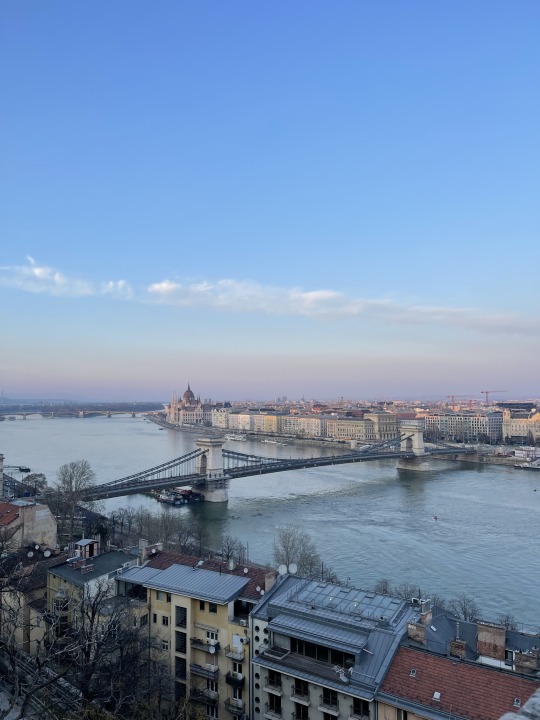
During the 8-hour train home, I took some time to reflect on my time in Prague so far and decided what I want going forward. One of my goals is to explore more of the Czech Republic, so I planned a few day trips this upcoming week. Stay tuned to hear about Karlovy Vary, a spa town in the west Bohemia region of the Czech Republic, and a guided tour of Terezin, a concentration camp 30 miles north of Prague in the Czech Republic during World War II.
Na Shledanou!
Emily Walker
Computer Science & Engineering
0 notes
Text
Week 8 (February 25 - March 30)
Ahoj!!
Again, very sorry that this post is coming almost a week late - I don’t have as much free time with my internship.
During the week, I mainly go to my internship and then on my free day this past week I caught up on some research that I’m supposed to be doing this semester as part of my fellows program at Elon. Doing the internship is definitely making the time go by really quickly because I’m at work all day, but I’m learning a lot of new things and it’s such a great experience to work for a German company.
Prague, Czech Republic
My program takes us on a weekend trip each block where it organizes the transportation, hotels, and things for us to do. I was really excited the trip for this block was to Prague, because I’ve heard such great things about it.
We took a train from Berlin to Prague on Friday morning and got there in the early afternoon. We always have to do one excursion as part of the trip, and honestly the options for Prague were a little strange. We ended up going to a museum about “tramping” in Prague, which was basically this idea of going out into the woods and camping on the weekends for young people in Prague in the early 1900s. It was a little boring, but if we only have to sit and listen to a tour for an hour in exchange for a free trip to Prague, I’m fine with it :)
That night, we had dinner with the people in our tour group. The restaurant was really cool - we were underground and it reminded me of being in a cave. I had a chicken dish with ham and cheese on top - very yummy!!

The next morning, we went on an early morning (7:30am) walking tour. Yes, I’m surprised we made it too! But it was definitely worth it to learn more about the history of the city and see the sites without the crowds of people.
The tour started off with the astrological clock, which was installed in 1410. The tour guide explained how to use it to tell the time, but it was a little complicated. Every hour, the clock chimes and the little figures move. One of the figures, which is supposed to represent Death, pulls a string that rings the bells and is meant to symbolize that every hour brings us closer to our death. It’s a little morbid, but also a good reminder.

Afterwards, we walked over the Charles Bridge. It’s really cool, because there are statues all along the sides and the views on both sides are beautiful. Our guide explained what all the statues symbolized, which was also helpful because we wouldn’t have known otherwise.




Our tour also showed us around the Old Square, which was really cute and it was awesome to be able to walk around without a bunch of people there too. Prague is really beautiful and was less damaged by WWII than most other Eastern European cities, so most of the buildings and architecture is original.

We also visited the Jewish Quarter, where one of the oldest Jewish cemeteries in Europe is located. We also saw the Old-New Synagogue, which is the oldest active Synangogue in Europe. We weren’t allowed to go in because it was Shabbat, but it was still very interesting to learn about.

Then, we went in a monastery that still has active Monks working there. It was really beautiful!

After the walking tour, we went to a nearby cafe and got some coffee and pastries.

Then, we walked around the city more! We went across the Charles Bridge again and walked to this area that overlooked the whole city. The area we walked around was really old and quaint.





We also saw the Prague Castle, which was really gorgeous.



We also found this really cool area right by the water where there were a bunch of swans! It was really beautiful!

We also found a really cool gingerbread store! The workers make all the cookies there and had so many cute designs. It smelled go good in the store too

Then, we went to the John Lennon Wall, which is a famous wall in Prague. It was started by this artist who painted his picture and come lyrics on the wall right after Lennon was killed. Now, a bunch of other people have added their own graffiti and messages on it. It’s really cool.
Also I got my hair cut!


We went back to to the hotel and rested a little bit and then found this cool park nearby and walked around for a while. It was a steep climb to the top, but really cool to see the city at night! There was also a waterfall.


That night, we went to this really cool restaurant where the drinks were served on a train! It was so cool. There were tracks around the whole restaurant and then the glasses where on these little trains that stopped right at the table. It’s a little hard to see in the picture because it was moving, but it was awesome!

On Sunday, we took the train back to Berlin. It was a wonderful trip and I had a lot of fun!
I am still having a wonderful time abroad and I miss you all!

1 note
·
View note